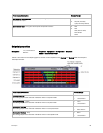
Sequence of Operation
42 RTU Open
The RTU Open supports various types of constant volume air source configurations:
• Standard heat/cool unit types with up to 2-stages of mechanical cooling and gas or electric heating
• Heat pump units utilizing a reversing valve output for heating and cooling control
• Heat pump unit (Carrier) with an OEM control board
• Economizer, CO2, Demand Limiting, and RH control strategies are available for appropriately equipped
units
The RTU Open may operate as part of a linked VVT system or as a stand-alone controller.
Occupancy
The RTU Open’s operation depends upon its occupancy state (Occupied/Unoccupied). The RTU Open
operates continuously in the
Occupied mode until you configure an occupancy schedule.
An occupancy schedule may be:
• A local schedule configured in the controller using BACview or Field Assistant
• A BACnet schedule configured in i-Vu, networked through an i-Vu Open Router
• A BACnet or local schedule configured for subordinate VVT Zones, networked through an i-Vu Open
Router(s) and employing Linkage
To set up occupancy schedules, consult the documentation for your user interface.
NOTE A BACnet schedule, downloaded from i-Vu will overwrite a local schedule that was set up with BACview
or Field Assistant.
Occupancy Source - the following settings determine occupancy. See Unit configuration (page 59).
Options:
• Always Occupied – Controller operates continuously, regardless of any configured schedule
• BAS On/Off – Occupancy is set over the network by another device or a third party BAS. Refer to the RTU
Open Integration Guide for additional instructions in communication protocols.
• Remote Occ Input – Controller monitors an input contact connected to one of the available binary inputs
configured to receive it. You must set
Unit Configuration > Occupancy Source to Remote Occ Input and
one
Input Switch Configuration to Remote Occupancy.
Sequence of Operation


















